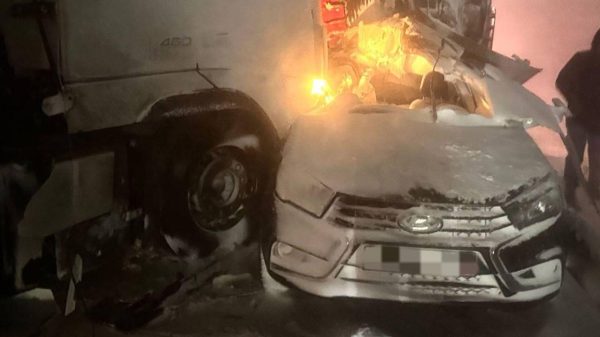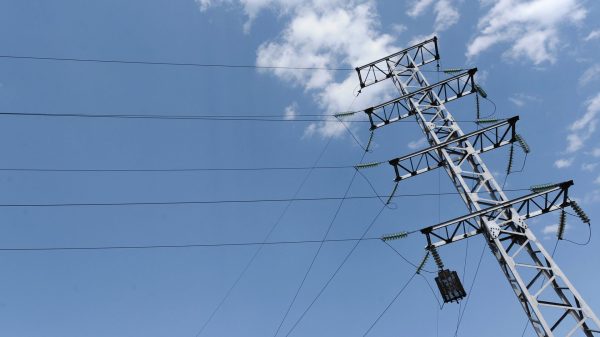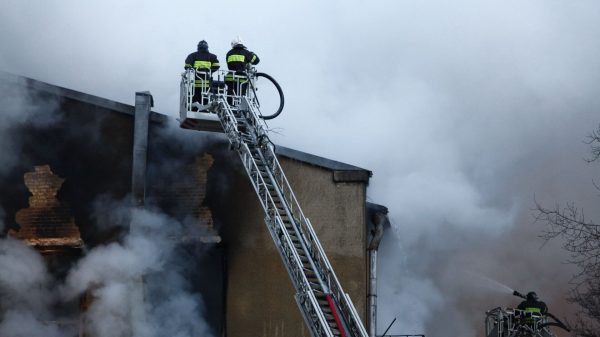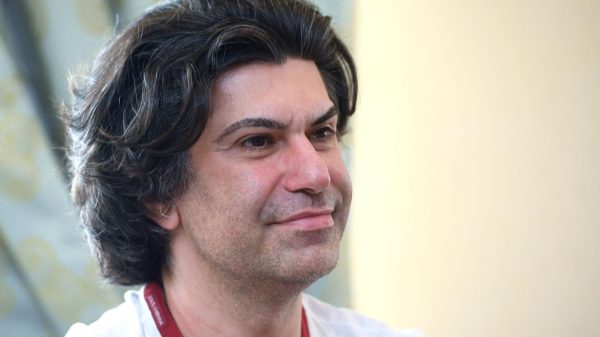Behind a pair of giant wooden planters bursting with green grasses and purple flowers, 30 or so secondary school students spread out across an empty residential road in Oval, in the London borough of Lambeth. The only sound is the rising swell of their banter and laughter as not a single car or van engine can be heard nearby.
Road congestion levels in outer London higher than before lockdown
Read more
Soon afterwards, scores of parents arrive on foot to pick up younger children from the nearby primary school. In various combinations of bikes, scooters and buggies, they too spill out onto quiet side streets, where vehicles are deterred by more verdant planters and red warning signss.
Jaquelin Gutierrez, 45, is walking beside her seven-year-old daughter, Lauren, who is riding her bike in the sunshine. They feel far safer than they used to on their 10-minute journey home without so many cars. “I used to be super scared because cars go really fast and might run over me,” says Lauren.
This is one of the many emergency low-traffic neighbourhoods – where barriers prevent motorists cutting through side streets but residents still have access in their cars – that have appeared since the government gave councils £250m of new “active travel” funding in May. The Welsh government has allocated £15.4m for reallocating roads space while the Scottish government has distributed £10m for emergency active travel measures.
In the last four months, more than 200 new schemes have been proposed across the UK, with restrictions on through traffic planned or implemented in at least 54 local authorities including Birmingham, Manchester and Edinburgh. The vast bulk of the schemes are in the capital, with London accounting for 141 of the neighbourhoods where rat runs have been, or could soon be, partially blocked by barriers.
“The government and councils needed to act fast because of Covid,” says Giulio Ferrini from walking and cycling charity Sustrans. “Lots of people understandably don’t want to travel on buses and trains during a pandemic so there’s a real risk those with cars will just drive more, causing gridlock and adding to dangerous levels of pollution, unless councils provide viable alternatives by making walking and cycling safer. This is what low-traffic neighbourhoods can do.”
Yet these apparently modest traffic management changes have sparked sometimes bitter rows, with increasing vocal opposition groups arguing the schemes only really benefit the entitled middle classes in leafy enclaves at the expense of those living in surrounding neighbourhoods or who are dependent on their cars.
There have been demonstrations in a number of London boroughs including Ealing, Wandsworth and Islington, with further protests taking place this weekend in Hackney. Petitions demanding the removal of low-traffic neighbourhood (LTN) schemes have attracted hundreds of signatures. Planters have even been overturned in Ealing, with oil poured onto the spaces left for bikes to pass through.
Most councils appear to be pressing ahead with emergency schemes despite the backlash. Yet last week, Conservative-controlled Wandsworth council broke ranks and suspended LTN trials citing concerns about traffic flows and emergency access.
Back in Lambeth, the Labour deputy leader of the council, Claire Holland, who has led the implementation of the emergency schemes in the borough, fears a culture war is breaking out between those who are for and against limiting through traffic.
“It is a culture war between those who want to drive wherever they want, whenever they want, at whatever speed they want – compared to the right of everybody else to get around peacefully and effectively,” says Holland, walking through the Oval scheme. “The truth is most of the people in this area don’t have a car, so driving is just not an option for them. This scheme is just about drivers sharing road space fairly with walkers and cyclists.”
Indeed, Holland has found herself caught up in these skirmishes. Her home address was published on social media recently by an account opposed to the LTN. “I’ve had my address tweeted out saying I’m ‘only doing it for personal benefit’ because I live here,” she says. “It is worrying but you just have to get on with it.”
It is far from an isolated incident. The police confirm officers spoke to one person after pictures were taken outside the homes of members of a local residents’ association, which supports the Oval scheme. The photos were later shared from a now deleted Twitter account that also referred to: “ignorant ivory tower wealthy finger pointing arseholes”.
Despite the increasingly rancorous nature of the debate, Holland argues the scheme is absolutely necessary and is already proving its worth. “We are seeing far fewer car journeys,” she says, gesturing down the carless road. “The main cut through used to have more than 4,000 cars a day. It is hugely safer now because it is not a rat run any more.”
Yet a short walk away, three residents involved in the One Oval group, which organised a protest outside the town hall last weekend, have a very different view. They argue that the scheme is displacing traffic to less prosperous areas and already heavily polluted main roads, where people on lower incomes are more likely to live.
Sam Cooray, who lives on the border of the scheme, claims the traffic that used to filter through the streets in the Oval triangle has ended up outside her home. “I’m between two main roads so I’m in a cloud of pollution, and my children are in a cloud of pollution,” she says, sitting in a park cafe beside a busy road.
Cooray, 42, adds that the proponents of the scheme are drawn from a very narrow, privileged section of the local population. “They are not representative of working classes, of BME communities, of the disabled, of local businesses,” Cooray claims.
I understand it’s difficult for people for whom success means a nice car. But I don’t think it warrants these attacks
Sarah Berry
She accuses the scheme’s backers of playing the “victim card” and has her own stories of intimidation and bullying. “I’ve been doxed [private information published online],” says Coonay. “We are being personally attacked and it’s appalling.”
The group also includes residents within the scheme. Jade Castello, 36, who lives on an estate within the LTN, says it is now harder for her to drive her youngest child to primary school as well as other activities further afield. “I’m always stuck in traffic – it’s terrible. It’s taking me much, much longer. I’m going out the same way with all the people from my estate,” she says. “I’m basically stuck in – I feel like a prisoner.”
Holland rejects the claim that the Oval scheme only benefits well-off home owners. She points out it includes 2,000 socially rented homes and 70% of the residents do not own cars. “This is an area full of council housing,” she says, walking past one of the five estates.
The Oval scheme is not the only road closure dividing opinion in Lambeth. The council, which received the highest active travel funding of any London borough, has already implemented four low-traffic neighbourhoods, with another planned for later this month.
Sarah Berry, who has blogged about taking up cycling since the streets around her home in Brixton were closed to through traffic, has been subjected to a campaign of harassment, which required the involvement of the police this week. “I got messages saying ‘you fucking tree hugger’ and ‘I’m going to run you down’,” she says pushing her bike thought the Railton Road low-traffic neighbourhood. “They figured out my address using photos I had posted. They put a lot of effort into making me feel terrified.”
Berry, who works for a charity, worries the debate about the scheme is becoming toxic and cannot understand the level of animosity directed at an enthusiastic new cyclist. “I understand it’s really difficult for people who have been told their whole lives that success means getting a nice car. But I don’t think that it warrants these kinds of attacks.”
Nonetheless, Berry is passionate about how the scheme has transformed her experience of the city, enabling her to first gain confidence on quiet streets before venturing further and further on two wheels. “For the first in my life I am completely in charge of where I go and how I get there and whether or not I stop and get a coffee. It’s completely changed my world,” she explains. “I fall into the category of someone who is incredibly unlikely to be getting on a bike – and yet here I am.”
She is not the only new cyclist in the area. A council-backed service for new riders, Peddle My Wheels, has seen a seven-fold increase in bike deliveries within the Railton Road scheme since April. The vast majority were new female riders.
While the street closures have given Berry and these new riders a sense of liberation, residents on the other side of the planters claim they have been cut off from the rest of the neighbourhood.
“That’s a very wealthy area,” says James Thomas, 32, gesturing towards the low-traffic neighbourhood. “It’s the heart of gentrification in Brixton. Now there’s a big barrier, and on our side of the road… there is a rubbish lorry depot and we take all the traffic.”
While it is far too early to tell if the new emergency schemes have encouraged active travel or just displaced traffic elsewhere, there is a growing body of evidence from the UK’s first low-traffic neighbourhood in Waltham Forest. Modelling by King’s College London suggests the east London borough’s ground-breaking mini-Holland scheme, which started life in 2014, has boosted life expectancy and air quality, without pushing up pollution on main roads.
New research into the transport habits of hundreds of Waltham Forest residents by the University of Westminster reveals car ownership fell inside the schemes while walking and cycling markedly increased within one year.
“We found that people in ‘high dose areas’ [of traffic interventions], including low-traffic neighbourhoods, were doing 40 to 45 minutes walking or cycling a week more than people in the control group,” says Professor Rachel Aldred, who co-authored the study, which was published last week.
Monitoring by the council shows there has been an overall fall in motor traffic across the entire borough – although there were small rises on the surrounding border roads. “The evidence shows there’s likely to be a mix of traffic displacement and ‘evaporation’ – ie some people will make journeys in other ways if driving becomes a bit more difficult,” says Aldred. “You wouldn’t expect 100% of people to stop driving but given current trends, without measures to discourage driving we will see much more traffic on all the roads.”
She adds measures such as low emission zones and widening pavements would help protect people living on main roads from traffic pollution.
Yet this research cannot explain exactly how specific traffic schemes will play out in practice – so the bitter arguments in Lambeth and elsewhere are likely to rage for some time yet.
As the sun begins to dip below the terraces and railway bridges in Brixton, Berry gets ready to cycle back to the rented home she shares with friends. Despite her unpleasant brush with some of the more extreme participants in this emerging traffic culture war, she is excited by how quickly people are reclaiming the spaces formerly occupied by belching cars, vans and lorries: “One of my favourite residents now is a man who uses a mobility scooter to ride up and down in the road while doing his shopping.”
Tempers rise on social media…
• “Can Ealing council stop trying to save face and be big enough to accept LTNs are a catastrophic mistake.”
• “I am fed up with anti #LTN mob using disabled as a pawn in their self-entitled argument when the #LTNs are there to help the marginalised.”
• “It’s shameful the way Wandsworth has caved to populism on #LTNs rather than promoting a long term #sustainable strategy.”
• “LTNs not only lengthen time in traffic, they also will cost the fragile economy in wasted business hours.”
• “We poor sods who live in the less favoured part are therefore classified as suitable for thru traffic.”
• “The LTN in Ealing now means one of my kids can walk home on his own.”






















































Свежие комментарии